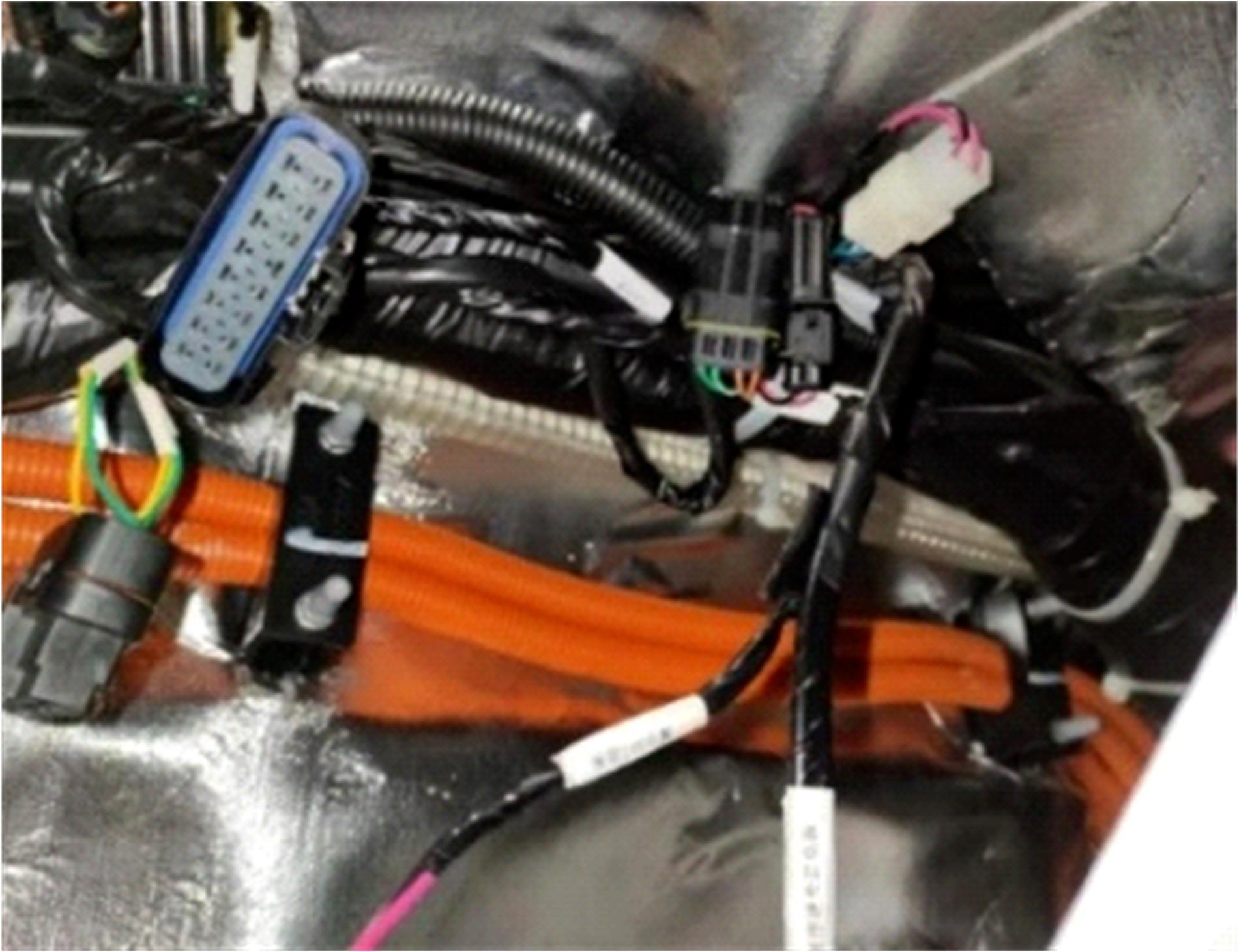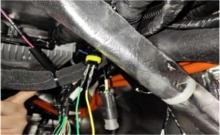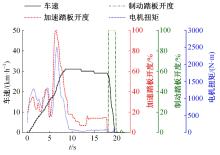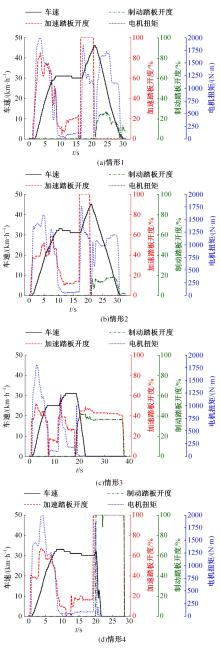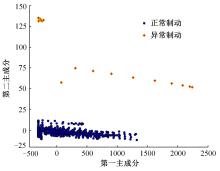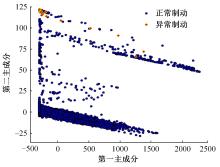Journal of Jilin University(Engineering and Technology Edition) ›› 2023, Vol. 53 ›› Issue (12): 3342-3350.doi: 10.13229/j.cnki.jdxbgxb.20220173
Identification method for electric bus pedal misoperation based on natural driving data
Wei YUAN1( ),Xiao-hui YUAN1,2,Yan GAO3,Kun-chen LI1,Deng-feng ZHAO4,Zhao-hui LIU4
),Xiao-hui YUAN1,2,Yan GAO3,Kun-chen LI1,Deng-feng ZHAO4,Zhao-hui LIU4
- 1.School of Automobile,Chang'an University,Xi'an 710064,China
2.School of Vehicle Engineering,Xi'an Aeronautical Institute,Xi'an 710077,China
3.Key Laboratory of Ministry of Public Security for Road Traffic Safety,Wuxi 214000,China
4.Zhengzhou Yutong Bus Company Ltd. ,Zhengzhou 450016,China
CLC Number:
- U471.3
| 1 | Zhang C, Gong B, He H, et al. Special investigation and countermeasure suggestions on electric vehicle out-of-control accidents[C]∥IOP Conference Series: Earth and Environmental Science, Dalian, China, 2020: 1-8. |
| 2 | Tran C, Doshi A, Trivedi M M. Pedal error prediction by driver foot gesture analysis: a vision-based inquiry[C]∥2011 IEEE Intelligent Vehicles Symposium (IV), Baden, Germany, 2011: 577-582. |
| 3 | Lococo K, Staplin L, Martell C, et al. Pedal application errors[R]. Washington DC: Department of Transportation, 2014. |
| 4 | Wu Y, Boyle L N, Mcgehee D V. Evaluating variability in foot to pedal movements using functional principal components analysis[J]. Accident Analysis & Prevention, 2018, 118: 146-153. |
| 5 | Wang X, Liu Y, Wang J, et al. Study on influencing factors selection of drive's propensity[J]. Transportation Research Part D: Transport and Environment, 2019, 66: 35-48. |
| 6 | 尹怡欣, 徐令仪, 徐雅璠, 等. 基于旋转编码器的汽车油门误踩检测[J]. 控制工程, 2013, 20(4): 611-613, 622. |
| Yin Yi-xin, Xu Ling-yi, Xu Ya-bo, et al. Detection of the mistaken pressing accelerator pedal based on encoder[J]. Control Engineering of China, 2013, 20(4): 611-613, 622. | |
| 7 | 曹菁, 孟宪皆. 基于联合判别参数的防误踩油门制动控制系统设计[J]. 广西大学学报: 自然科学版, 2016, 41(2): 470-479. |
| Cao Jing, Meng Xian-jie. Brake control system design against mistakenly stepping on accelerator based on joint discriminate parameter[J]. Journal of Guangxi University (Nat Sci Ed), 2016, 41(2): 470-479. | |
| 8 | 苑警支. 基于多传感器融合的误踩油门辅助系统控制方法研究[D]. 长春: 吉林大学交通学院, 2019. |
| Yuan Jing-zhi. Research on control strategy of assistance system for misoperation of accelerator pedal based on multi-sensor data fusion[D]. Changchun: College of Transportation, Jilin University, 2019. | |
| 9 | 王力斌, 刘树伟. 基于模糊推理的油门防误踩系统控制研究[J]. 控制工程, 2020, 27(8): 1462-1467. |
| Wang Li-bin, Liu Shu-wei. Research on the control system of preventing false stepping the accelerating pedal based on the fuzzy theory[J]. Control Engineering of China, 2020, 27(8): 1462-1467. | |
| 10 | 邓彪, 简晓春. 汽车误踩油门智能保护系统的设计[J]. 交通科学与工程, 2014, 30(2): 67-71. |
| Deng Biao, Jian Xiao-chun. Design of an intelligent protection system for cars stepped on the accelerator by mistakes[J]. Journal of Transport Science and Engineering, 2014, 30(2): 67-71. | |
| 11 | Rogers S B, Wierwille W W. The occurrence of accelerator and brake pedal actuation errors during simulated driving[J]. Human Factors, 1988, 30(1): 71-81. |
| 12 | Jia S, Hui F, Li S, et al. Long short-term memory and convolutional neural network for abnormal driving behaviour recognition[J]. IET Intelligent Transport Systems, 2020, 14(5): 306-312. |
| 13 | 佘承其, 张照生, 刘鹏, 等. 大数据分析技术在新能源汽车行业的应用综述——基于新能源汽车运行大数据[J]. 机械工程学报, 2019, 55(20): 3-16. |
| She Cheng-qi, Zhang Zhao-sheng, Liu Peng, et al. Overview of the application of big data analysis technology in new energy vehicle industry: based on operating big data of new energy vehicle[J]. Journal of Mechanical Engineering, 2019, 55(20): 3-16. | |
| 14 | Lattanzi E, Freschi V. Machine learning techniques to identify unsafe driving behavior by means of in-vehicle sensor data[J]. Expert Systems with Applications, 2021, 176: 1-10. |
| 15 | van LY M, Martin S, Trivedi M M. Driver classification and driving style recognition using inertial sensors, 2013[C]∥2013 IEEE Intelligent Vehicles Symposium (IV), Gold Coast, Australia, 2013: 1040-1045. |
| 16 | Schmidt R A. Unintended acceleration: a review of human factors contributions[J]. Human Factors, 1989, 31(3): 345-364. |
| 17 | Schölkopf B, PLATT J C, Shawe-taylor J, et al. Estimating the support of a high-dimensional distribution[J]. Neural Computation, 2001, 13(7): 1443-1471. |
| 18 | Liu F T, Ming K, Zhou Z. Isolation forest[C]∥2008 Eighth IEEE International Conference on Data Mining, Pisa, Italy, 2008: 413-422. |
| [1] | Qing-tian GENG,Zhi LIU,Qing-liang LI,Fan-hua YU,Xiao-ning LI. Prediction of soil moisture based on a deep learning model [J]. Journal of Jilin University(Engineering and Technology Edition), 2023, 53(8): 2430-2436. |
| [2] | Heng-yan PAN,Wen-hui ZHANG,Ting-ting LIANG,Zhi-peng PENG,Wei GAO,Yong-gang WANG. Inducement analysis of taxi drivers' traffic accidents based on MIMIC and machine learning [J]. Journal of Jilin University(Engineering and Technology Edition), 2023, 53(2): 457-467. |
| [3] | Feng-feng ZHOU,Zhen-wei YAN. A model for identifying neuropeptides by feature selection based on hybrid features [J]. Journal of Jilin University(Engineering and Technology Edition), 2023, 53(11): 3238-3245. |
| [4] | Qing-tian GENG,Yang ZHAO,Qing-liang LI,Fan-hua YU,Xiao-ning LI. Integrated LSTM and ARIMA method based on attention model for soil temperature [J]. Journal of Jilin University(Engineering and Technology Edition), 2023, 53(10): 2973-2981. |
| [5] | Liang DUAN,Chun-yuan SONG,Chao LIU,Wei WEI,Cheng-ji LYU. State recognition in bearing temperature of high-speed train based on machine learning algorithms [J]. Journal of Jilin University(Engineering and Technology Edition), 2022, 52(1): 53-62. |
| [6] | Guang-song LI,Wen-qing LI,Qing LI. Encrypted and compressed traffic classification based on random feature set [J]. Journal of Jilin University(Engineering and Technology Edition), 2021, 51(4): 1375-1386. |
| [7] | Xiao-long ZHU,Zhong XIE. Geospatial data extraction algorithm based on machine learning [J]. Journal of Jilin University(Engineering and Technology Edition), 2021, 51(3): 1011-1016. |
| [8] | Yao-rong CHENG,Qian YANG,Guo-hua ZHENG. Tractor scheduling optimization of drop and pull transport in large⁃scale manufacturing enterprises considering carbon emission [J]. Journal of Jilin University(Engineering and Technology Edition), 2021, 51(3): 893-899. |
| [9] | Wei FANG,Yi HUANG,Xin-qiang MA. Automatic defect detection for virtual network perceptual data based on machine learning [J]. Journal of Jilin University(Engineering and Technology Edition), 2020, 50(5): 1844-1849. |
| [10] | Yang LI,Shuo LI,Li-wei JING. Estimate model based on Bayesian model and machine learning algorithms applicated in financial risk assessment [J]. Journal of Jilin University(Engineering and Technology Edition), 2020, 50(5): 1862-1869. |
| [11] | Zhou-zhou LIU,Wen-xiao YIN,Qian-yun ZHANG,Han PENG. Sensor cloud intrusion detection based on discrete optimization algorithm and machine learning [J]. Journal of Jilin University(Engineering and Technology Edition), 2020, 50(2): 692-702. |
| [12] | ZHAO Dong, ZANG Xue-bai, ZHAO Hong-wei. Random forest prediction method based on optimization of fruit fly [J]. 吉林大学学报(工学版), 2017, 47(2): 609-614. |
| [13] | WU Qi, LIU Jian-nan, KOU Wen-long, ZHANG Zong-sheng. Internet traffic identification by using improved one class support vector machines [J]. 吉林大学学报(工学版), 2013, 43(增刊1): 124-127. |
| [14] | WANG Guo-lin, FU Nai-ji, ZHANG Jian, PEI Zi-rong. Simulation of the radial tire curing process based on K-R kinetic model [J]. 吉林大学学报(工学版), 2013, 43(03): 659-664. |
| [15] | TU Wei-wei, LI Ming, ZHOU Zhi-hua. Mining software defect factor [J]. 吉林大学学报(工学版), 2012, 42(增刊1): 382-386. |
|
||

